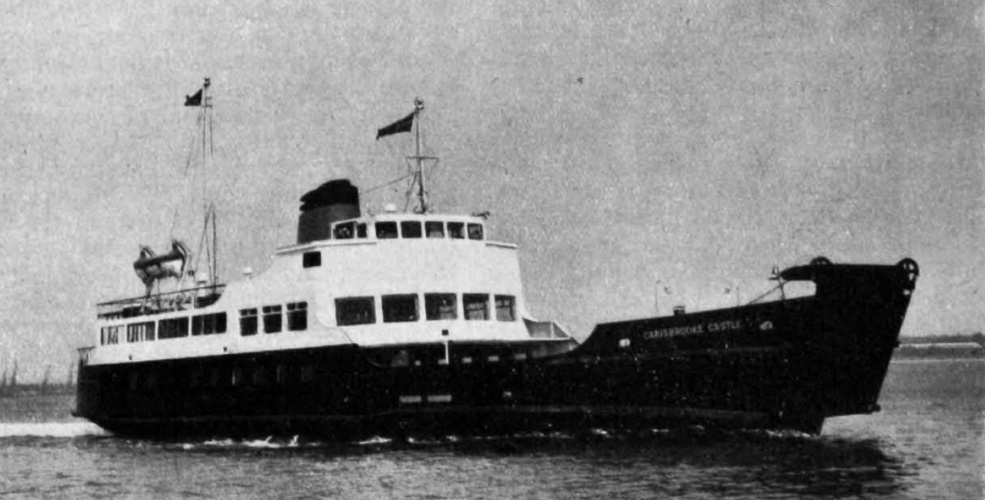
This month’s visit to the archive documents the specs of a car and passenger ferry built for a company still going strong after 160 years.
Southampton-based Red Funnel currently carries 2.3m passengers and over 857,000 vehicles on its ferry route between the Port of Southampton and East Cowes, and over 1.1m passengers between Southampton and West Cowes on its 38 knots Red Jet Hi-Speed service.
Several decades previously Red Funnel’s paddle steamers operated at well under half the speed whilst traversing their routes or taking passengers on excursions, but this was to change with the advent of the private motor car a consumer desire to explore the Isle of Wight on four wheels.
READ THE ORIGINAL ARTICLE
Red Funnel’s Norris Castle, a converted tank carrying craft, was already employed as a car ferry but demand was outpacing supply and by June 1959 the company had welcomed the Carisbrooke Castle as it looked to modernise and increase facilities for car transport.
A certain GW Tripp set about providing a potted twentieth century history of Red Funnel’s vessels before concentrating on the Carisbrooke Castle, which was built by John I Thornycroft and Co Ltd to accommodate 45 vehicles and 500 passengers.
According to Tripp, loading and unloading vehicles was effected by an articulated ramp at the extreme fore end of the vessel and via side loading where sliding ship side doors gave access to the sheltered car deck, and hinged bulwark doors allowed larger vehicles onboard.
“To assist in the towage of vehicles a turntable with a diameter of 13ft is fitted flush into the after end of the car deck to enable vehicles to be stowed advantageously,” Tripp said.
The deck machinery, said Tripp, was of the hydro-electric type and consisted of one cable lifting and warping capstan on the starboard side and one warping capstan on the port, both being fitted forward, and two ramp hoisting winches placed in machinery houses port and starboard forward and one warping capstan fitted aft.
“The steering gear is hand and power electric hydraulic, the motor, rams and pump being positioned in the steering compartment coupled to twin spade rudders, the bridge control being by telemotor gear,” he added.
The main propelling machinery was supplied by Crossley Brothers, Ltd, an Openshaw, Manchester-based company which became part of Rolls-Royce in 1988. According to Tripp, it consisted of two type HRN 8/45 vertical two-stroke cycle direct reversing marine diesel engines, each engine having eight cylinders with a bore of 10·5 inches and a stroke of 13·5 inches ‘giving a continuous rating of 900bhp at a speed of 450rpm, the total brake horsepower being 1800’.

“The line shafting runs in ‘Mitchell’ plummer blocks, and the propeller shafts run in oil bath stern tube, with ‘United States’ rotary metallic packings fitted at both the inboard and outboard ends of tubes,” Tripp noted. “The propellers are three bladed of manganese bronze, designed and manufactured by the builders. A mean speed of 14·7 knots was obtained on trials, the required service speed being 14 knots.”
For passenger comfort and safety, a specially designed ‘Thornycroft funnel’ housed silencers and prevented exhaust gases from coming on the deck.
Electrical power at 220VDC was normally supplied by the three 50kW diesel generators, but because certain services were required to run through the night a 5kW motor generator was fitted to operate from a shore supply.
READ MORE ARTICLES FROM THE ENGINEER'S CLASSIC ARCHIVE
“As this supply differs at the two terminal ports, being 415V three phase at Southampton, and 480V single-phase at Cowes, a transformer has been incorporated in the motor generator set so that it may run from either,” Tripp said.
Summing up, Tripp said: “This ship would appear to be admirably suited to the work it will be called on to undertake, and from the point of view of the passenger is the most comfortable vessel plying between the mainland and the Isle of Wight.”
On its website Red Funnel notes: “Although not an attractive ship, she was effective in her role, carrying 15,829 cars and 3,147 commercial vehicles in the first six months. She could also make the trip to Cowes in 40 minutes!”
Carisbrooke Castle served Red Funnel for 15 years before being sold to operate in warmer waters off the coast of Naples.










McMurtry Spéirling defies gravity using fan downforce
What a fun demonstration. I wonder if they were brave enough to be in the car when it was first turned over. Racing fan cars would be an interesting...